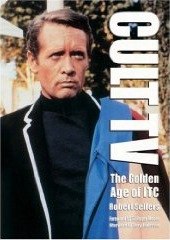CULT TV
The Golden Age of ITC
By Robert Sellers
Plexus Publishing (London), 2006. 288 pages. $19.95 (softbound)
Britain’s ITC, headed by the legendary broadcasting mogul Sir Lew Grade, was the source of virtually all the memorable (and a few not so memorable) British television adventure series of the 1960s. Grade set out to make ITC the only supplier of American-quality, filmed adventure shows in the prim British TV market and to match Hollywood’s standards in order to crack the U.S. market. He succeeded beyond anyone’s expectations, producing the most popular adventures series seen on Britain’s Independent Television network, placing series on all three American networks and selling the shows in scores of other countries.
Beginning with The Adventures of Robin Hood, which ran on ITV from 1956 to 1960 and in the U.S. on CBS from 1955 to 1958, ITC followed with other costume dramas such as The Buccaneers and William Tell, and the gimmicky Invisible Man that led the way to the golden era of Danger Man, The Saint, Secret Agent, The Baron, Man in a Suitcase, The Prisoner, The Champions, Strange Report, UFO, The Persuaders, Department S, and of course Gerry and Sylvia Anderson’s “Supermarionation” shows (Supercar, Fireball XL5, Thunderbirds, et. al.). Every popular British adventure series seen in America — with the notable exception of The Avengers — came from ITC, making the company’s output a key reason that the 1960s are remembered as the golden age of TV adventure.
While ITC’s biggest shows have had several books devoted to them, Cult TV is the first to cover the complete story of the company and it’s programs. Author Robert Sellers reports and writes the story in a thorough and entertaining manner that’s a pleasure to read. He obviously enjoyed access to ITC’s archives, giving him the inside scoop on production and allowing the book to reproduce dozens of photos, both production stills and behind-the-scenes (a shot of Roger Moore and Patrick Macnee sharing afternoon tea at Elstree Studios is priceless), as well as studio promotional material and period memorabilia.
Sellers also tracked down and quizzed notable survivors of the era for their insights — producers such as Monty Berman, Robert Baker, Brian Clemens and the Andersons; directors (Clive Donner, Peter Graham Scott, Ray Austin, Roy Ward Baker, Cyril Frankel, John Glen); series stars including Roger Moore, Richard Bradford, William Gaunt, Alexandra Bastedo, Ed Bishop, Barry Morse, Tony Curtis, Robert Vaughn and Peter Wyngarde; and some of the supporting players who turned up time and again in ITC shows (Jane Merrow, Shirley Eaton, Sue Lloyd, Annette Andre, George Baker).
Some shows naturally come in for more coverage than others. My only real disappointment is that shows considered also-rans, like The Baron, Strange Report and The Adventurer, get short shrift in a closing catch-all chapter. Granted, The Adventurer was an extraordinarily lousy effort on ITC’s part, but its equally crappy contemporary The Protectors receives full coverage.
Of course, some shows I’d hoped to learn more about get no coverage at all, among them Court Martial, the World War II legal drama starring Peter Graves and Bradford Dillman; the short-lived Man of the World starring Craig Stevens as a globetrotting photographer; and Espionage, the classy anthology of spy tales. At least they make the list of ITC’s full catalog in the back of the book, where everything gets the basic facts — dates, cast, number of episodes, etc.
I also would like to have seen some detail about ITC’s founding in 1955 and its demise as a television production company in 1982. But what’s here more than makes Cult TV a must for anyone with the slightest interest in television’s golden age of adventure.
Craig Henderson




